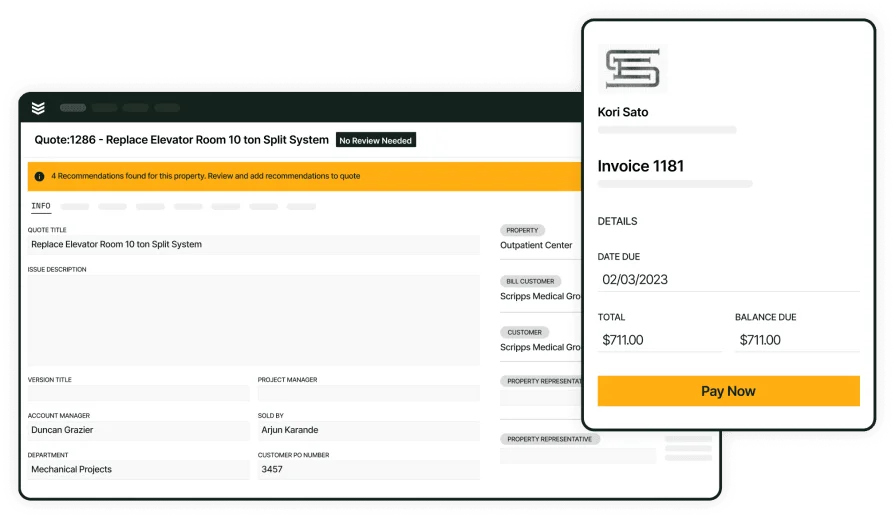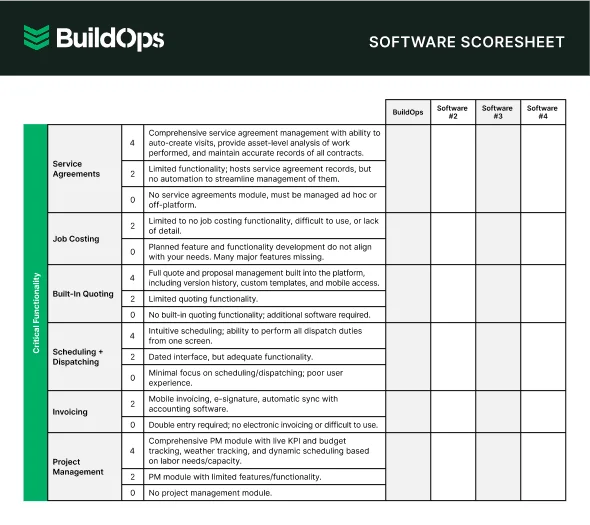Important
While BuildOps does not currently offer a tree service estimate software, we’re always looking into new and exciting tools and technology that are moving the industry forward, which is why we’re discussing the subject here.
If you run a tree service crew, winning bids start with tight numbers and fast paperwork. A bad quote can erase profit, and spreadsheets slow everything down. That’s where tree service estimate software helps. It handles labor, equipment, dump fees, and profit in one place—and connects cleanly with everyday tools like scheduling, dispatch, and field service management so the office and field stay in sync.
- Choosing tree service estimating software for your needs
- Tree service estimating software key features
- 7 best tree service estimating software options
- Tree service estimate software benefits
- 4 common tree care estimating software FAQs
Not every platform fits the same kind of tree work. Your choice depends on crew size, services you offer (removals, pruning, stump grinding), and how detailed your quotes need to be. Before we dig into key features, let’s lock in what to weigh when choosing a best-fit estimating tool.
Choosing tree service estimating software for your needs
You’ve set the goal—fast, accurate bids your crews can trust. Now pressure-test any tree service estimate software with questions that match how your team actually works in trucks and in the office.
- Team & speed – Who builds estimates—owner, estimator, or crew lead? How quickly can they quote in a driveway and back at the desk? Can a new hire learn it without a long ramp?
- Pricing model – Does it support fixed price and time-and-materials in one workflow? Can you set labor and equipment rates for arborists, climbers, ground crew, cranes, and stump grinders? Can you apply consistent markups and margins across services?
- Site risk – Can you record DBH, species, canopy spread, and drop zone? Can you flag hazards like power lines or tight access and have that change price automatically? Can you attach permits, notes, and photos to the estimate?
- Schedule handoff – When a client accepts, can it become a work order and crew assignment in one step? Can you reserve equipment and time windows from the estimate? Does it prevent double booking during busy weeks?
- Mobile capture – Will it work with weak signal on phones or tablets? Can techs add photos, notes, and signatures on-site? Do updates sync back to the office once service returns?
- Integrations & data flow – Will invoices push to accounting without retyping? Does it sync customers and jobs with CRM and field service tools?
- Costs & support – What will you pay per seat and for add-ons? Is onboarding included, and how long does it take? Can you reach live support during storm surges and weekends?
- Reporting – Can you see the win rate, average ticket, and margin by service line? Can you track estimator performance and quote turnaround time? Can you export reports for pricing reviews?
- Features – Which capabilities are non-negotiable for your crews? Do you need tree catalogs, assemblies, site mapping, and estimate-to-invoice conversion? What would speed up your tree service estimating software workflow every day?
Answer these and you’ll have a clear shortlist. Next, we move into the key capabilities that set strong tree care estimating software apart and how they help your office staff and field teams deliver clean, profitable jobs.
Tree service estimating software key features
Getting a bid wrong can drain profit fast. Crews juggle cranes, stump grinders, dump fees, and hazards that swing labor hours. Having estimating software keeps numbers tight and moves accepted quotes straight into field execution. Below are the features that matter for daily work, whether you run one bucket truck or a multi-crew operation using tree service estimating software across the office and field.
1. Scheduling and dispatch connected to estimating
Estimates only pay off when they hit a calendar and a crew. Look for estimating that hands off cleanly to field service scheduling and ties into dispatch software so travel time, crew skills, and equipment availability match the scope. For example, after pricing a 60-inch oak removal with crane time, the estimator converts the quote; the dispatcher assigns a climber, books the crane, and routes the chip truck—conflicts flagged before they burn hours.
2. CRM history that sharpens every quote
A strong estimate reflects site history and customer context. With service CRM tied to estimating, you see notes, photos, and past pricing while building the proposal. Say a property manager requests a pruning package across five buildings; the estimator pulls last season’s rates and photos, updates DBH and canopy spread, and sends a clean quote that lines up with expectations.
3. Estimate-to-invoice with deposits and progress billing
Closing the work cleanly keeps cash moving. Estimating should flow straight to invoicing and online payments so you convert an accepted estimate into an invoice, take a deposit at approval, and issue progress draws on larger removals. Case in point: a storm cleanup grows by two loads; the foreman logs dump tickets on-site, accounting pushes an updated invoice, and the client pays the balance the same day from a secure link.
4. Reporting that tunes pricing and performance
You can’t fix what you can’t see. Tie estimating to analytics & reporting to watch win rate, margins by service type, average ticket, and quote turnaround. During leaf-drop season, reports show stump grinding margins lagging; you adjust assemblies and hazard factors, then check next week’s numbers to confirm the lift.
5. Fleet and equipment impact on costs
Equipment drives both schedule and price. With fleet management feeding estimating, rates reflect ownership costs and availability for chippers, stump grinders, loaders, and cranes. On a packed Friday, your estimator sees the chipper booked; the quote switches to an alternate crew with updated travel time so the margin stays intact.
6. Service agreements for recurring care
Recurring work smooths the calendar and stabilizes revenue. Estimating that supports service agreements lets you package seasonal pruning, inspections, and storm prep into clear terms. Here’s a common scene: an HOA renews a multi-site plan, your team spins up updated estimates in a few clicks, and priority visits lock onto the calendar months ahead.

Quote faster. Win better tree work.
Create accurate quotes in minutes with an estimate-to-invoice flow.
7 best tree service estimating software options
To get full value from tree service estimate software, you want a platform that matches crew size, job mix, and how you quote in the field. Below, we compare leading options contractors often consider, adapted from our estimating guide format.
1. Best for commercial contractors: BuildOps
Built for high-volume service work, BuildOps delivers a connected estimating workflow that suits commercial tree care—fast pricing, job costing, proposal build-out, and a smooth handoff to scheduling and billing in one system. Teams that handle multi-site portfolios or HOA contracts can keep every quote, work order, and invoice tied together without extra data entry.
How pricing works: BuildOps follows a customized plan based on your operation’s size and requirements, so you pay for capabilities that impact estimating and bidding.
Features beyond estimating:
- Real-time cost tracking and job costing
- Automated labor and material calculations
- Seamless integration with scheduling and invoicing
What sets it apart for commercial: BuildOps tailors the estimating workflow to complex, multi-crew service operations—automated takeoffs, accurate cost tracking, and tight integrations that connect office and field.

Explore our estimating tools
See how we speed up estimating and bidding so your team wins consistently.
2. Best for residential contractors: Housecall Pro
Image Source: Housecall Pro
Housecall Pro offers an intuitive toolset for small tree care teams—quick quoting, basic scheduling, and customer messaging—so homeowners get fast, clean proposals. It suits light residential tree work, but larger commercial crews may outgrow its job costing depth and integrations for multi-phase service.
How pricing works: Tiered plans let you choose a package that matches team size and needs.
Features beyond estimating:
- Built-in scheduling and dispatching tools
- CRM features for customer management
- Mobile app for on-the-go estimate creation
What sets it apart for residential: A simple all-in-one approach helps small contractors send estimates, manage customers, and schedule from a mobile device. Still, advanced cost tracking for large contracts can feel limited.
3. Best for general contractors: Jobber
Image Source: Jobber
Jobber covers quoting, time tracking, and estimate management with a clean interface, helpful for mixed-service outfits that include tree work. Small teams get speed and simplicity; however, contractors needing deep customization or stronger reporting may find the feature set too basic for heavy volumes or complex operations.
How pricing works: Three pricing tiers give flexibility to select a plan that fits your business.
Features beyond estimating:
- Quick quote creation
- Real-time job tracking and task management
- Mobile app for field–office sync
What sets it apart for general contractors: A straightforward platform that balances quoting, scheduling, and billing, though larger firms may want richer analytics.
4. Best for large-scale projects: Simpro
Image Source: Simpro
Simpro offers advanced job costing, automated takeoffs, and granular material tracking—useful for enterprises managing heavy contracts or public works that include vegetation management. That depth comes with complexity, which can feel heavy for smaller crews focused on daily removals, pruning, and stump grinding.
How pricing works: Subscription-based tiers vary by company size and features—larger teams tend to gain the most value, while small operations may find the toolset excessive.
Features beyond estimating:
- Integrated inventory management
- Automated takeoff tool
- Integrations with accounting and field platforms
What sets it apart for large-scale projects: Detailed costing and material controls help estimates reflect reality across multi-phase contracts.
5. Best for quick estimates: Clear Estimates
Image Source: Clear Estimates
Clear Estimates focuses on speed with prebuilt templates and editable pricing databases—handy for small tree care outfits quoting standard trims or stump grinding. It serves quick-turn needs well, yet it lacks deeper integrations and advanced reporting that larger service businesses expect.
How pricing works: Low-cost subscription designed for small teams; integration depth is limited.
Features beyond estimating:
- Pre-loaded templates for service quotes
- Customizable databases for materials and labor
- Simple customer management for storing past estimates
What sets it apart for quick estimates: Lightweight and easy to deploy; best when you need a fast quote engine without complex extras.
6. Best for fast estimate sharing: Workiz
Image Source: Workiz
Workiz focuses on quick digital estimates and client communication for service businesses, which fits residential and emergency tree work that needs fast turnarounds. Crews can create an estimate on a phone, send it by text or email, track views and approvals, and collect deposits through its payments tools, helping tree service estimate software users respond the same day after storms. That communication-first approach may feel light for companies that need complex assemblies, hazard multipliers, or multi-crew job costing for larger commercial contracts.
How pricing works: Tiered subscription plans with feature bundles and user-based options.
Features beyond estimating:
- Text and email delivery with approval and status tracking
- Integrated payments and deposits for faster cash flow
- Mobile app that supports on-site quoting and customer messaging
What sets it apart for communication-heavy teams: A tight estimate-to-approval loop that speeds decisions after urgent calls; however, deep costing and enterprise-level reporting may require additional tree service estimating software capabilities.
7. Best for sales-driven teams: Estimate Rocket
Image Source: Estimate Rocket
Estimate Rocket excels at fast estimate creation and automated follow-ups, helpful for door-to-door canvassing after storms or seasonal campaigns. It streamlines proposals for residential and light commercial jobs, though larger firms with heavy commercial contracts may want stronger job costing and enterprise-grade controls.
How pricing works: Subscription plans vary by users; keep in mind that HVAC-focused integrations referenced in guides may not translate directly to every tree care workflow.
Features beyond estimating:
- Fast proposal generation with digital signatures
- Automated follow-up reminders
- Simple invoicing and job tracking for small teams
What sets it apart for sales-led teams: Handy when speed and follow-up cadence decide who gets the job, yet heavy commercial contractors may want stronger costing features.

Compare software at a glance
Find the ideal software for your crew with this easy-to-use scoresheet.
Tree service estimate software benefits
Choosing tree service estimate software pays off when it speeds quoting, sharpens pricing, and keeps crews moving. Here’s how the gains show up for teams that bid, schedule, and invoice every day.
1. Faster, accurate bids
Speed wins busy seasons. Estimators build quotes in minutes, apply hazard factors, and send polished proposals without retyping. Tied to scheduling and dispatching best practices, accepted estimates land on the calendar quickly, which cuts delays and locks in jobs before competitors circle.
2. Stronger margins on every service
Small math slips erase profit. Tree care estimating software tracks real labor, equipment, and disposal costs, then applies consistent markups. You see true margin by service—removals, pruning, stump grinding—so pricing decisions stay disciplined through storm surges and tight weeks.
3. Consistent pricing across crews and sites
Standard templates and item libraries keep quotes uniform, even when multiple estimators work the same account. Storing site history and photos inside field service CRM software gives context at quote time—DBH, access limits, power lines—so pricing stays steady from visit to visit.
Deep Dive
Using field service CRM software keeps every site detail in one place—tree inventory, DBH, hazard tags, photos, and past approvals—so estimators and crew leads quote from the same playbook.
When that record ties into your tree service estimating software templates and markups, pricing stays consistent across visits, dispatch sees the context in the schedule, and crews arrive with gear suited to the scope.
4. Clear job planning and resource allocation
A precise estimate lays out labor hours, equipment blocks, and dump runs. Ops can stage cranes, route chip trucks, and reserve specialty gear without guesswork. That clarity trims idle time and tightens daily routes for each crew.
5. Fewer budget overruns
Detailed breakdowns expose risky assumptions early. When costs shift—extra rigging, tight access, added debris—teams update the estimate and flag budget impact before boots roll. Fewer surprises, cleaner closeout.
6. Higher win rate with smarter follow-up
Branded proposals and timely check-ins lift approvals. With customer history and reminders organized in a contractor CRM workflow, teams nudge open bids at the right moment and keep relationships warm between visits.
7. Faster cash flow after the job
Estimate, complete work, then bill without duplicate entry. A connected invoice app for contractors turns accepted quotes into invoices, captures deposits and final payments, and reduces days sales outstanding. That keeps trucks fueled and crews paid—proof that tree service estimating software drives the entire job cycle, not just pricing.
4 common tree care estimating software FAQs
After dialing in templates and margins, crews usually hit the same sticking points—setup, field use, integrations, who should adopt it, and the habits that keep pricing tight. The notes below zero in on teams rolling out tree service estimate software, with guidance that applies across tree care estimating software and everyday tree service estimating software workflows.
1. What is tree service estimate software?
Tree service estimate software helps contractors build fast, accurate bids. It automates multiple parts of the operation, like labor, equipment, dump fees, and markups, then produces professional proposals that connect to scheduling, dispatch, CRM, and invoicing for easy all-around management.
2. How does tree service estimating software work?
You enter scope items (removal, pruning, stump grinding), DBH, species, site hazards, travel time, and equipment. Price books and assemblies apply rates and markups, totals update instantly, and the proposal sends for e-signature. Once approved, it converts to a work order, a scheduled crew, and finally an invoice.
3. Who should use tree care estimating software?
Any tree service—solo owner-operator, residential crew, commercial team, storm response unit, or municipal contractor—benefits when spreadsheets and manual math slow quoting. If consistency, speed, or handoffs to field ops cause rework, tree care estimating software tightens the process.
4. What are best practices for using tree service estimate software?
Use these habits to get consistent results with tree service estimating software. They help crews quote accurately and keep margins healthy
- Standardize assemblies for removals, pruning tiers, and stump diameter ranges
- Capture DBH, species, access limits, and hazards with photos on every estimate
- Apply uniform labor and equipment rates with clear markups and profit targets
- Use mobile devices for on-site quoting and client approvals
- Convert approved estimates directly into work orders and scheduled visits
- Tie estimates to dump tickets and material receipts for clean job costing
- Track win rate, average ticket, and margin by service to tune pricing
- Store site history in CRM so any estimator can quote with the same context
- Require deposits on high-value jobs and progress draws on multi-day work
- Review closed jobs weekly and update assemblies when costs shift
Strong estimates set the pace for every crew. When pricing lines up with scheduling, dispatch, CRM, invoicing, payments, and reporting, your office and field move as one team. That combo turns quotes into clean work orders, keeps cranes and chippers where they need to be, and shortens the gap from approval to cash in the bank.
Use the question list in this guide to stack vendors side by side and focus on the pieces that actually change your day: assemblies that reflect real tree work, mobile quoting in a driveway, hazard factors that adjust totals, and fast handoffs to the calendar.
If you run commercial crews and want an all-in-one platform that ties estimating to every step of field service, BuildOps brings those tools under one roof.

Hit 75% quote approvals with BuildOps
Simplify estimates, speed up approvals, and keep jobs running smoothly.







